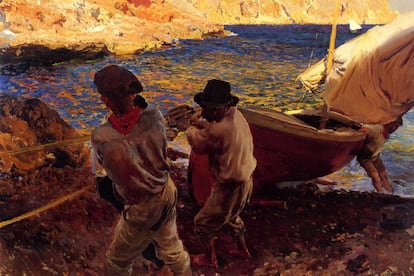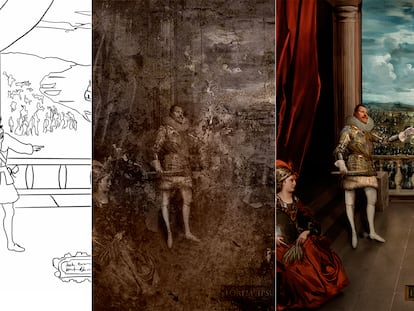How a damaged painting hesitatingly attributed to Velázquez could change the art market in Spain
The Supreme Court is deliberating whether to allow the export of the painting ‘Portrait of a Cleric.’ If it rules in favor of the sale, the decision could open up the doors to the sale of artistic heritage abroad, where it commands higher prices


Spain’s Supreme Court will announce at the end of the year a decision that could open the gates for the sale of Spanish artistic heritage abroad. Rafael Mateu de Ros, a partner in the Ramón y Cajal law firm, has been locked in a legal battle with the regional government of Madrid and the Spanish state for three years over the canvas Portrait of a Clergyman (circa 1623), attributed, with enormous hesitation, to the master Diego Velázquez (1599-1660).
In 2022, the regional government of Madrid gave the painting BIC designation (Asset of Cultural Interest, the highest possible protection), which makes it unexportable. But the Royo-Villanova family, which owns the artwork, wants to sell it outside Spain, where the asking price would be much higher. “What is worth €10 here, is worth €40 abroad,” figures the lawyer.
There are significant doubts regarding the authorship of the painting. No world-renowned expert, including the late art historian and Hispanist Jonathan Brown (1939-2022), has fully confirmed that the painting is by Velázquez. And the canvas is in a poor state of conservation: it lacks pictorial material and has lost volume and shadows. “It is in a very delicate condition,” notes the antique art dealer José Antonio de Urbina. But the BIC designation report says that “it is a portrait of undoubted technical and artistic quality, which maintains close technical similarities with works painted by Diego Velázquez and whose mastery is invaluable for understanding the evolution of portraiture in the first decades of the 17th century.”
The Supreme Court has accepted an appeal filed by the Ramón y Cajal law firm. A panel of justices must now decide whether to assign equal value to an expert report filed by the owners of the work and to another report drafted by experts from the culture ministry.
If the court’s decision favors the owners, it could set a precedent and put Spanish heritage at risk. The owners’ lawyers argue that each painting must be analyzed on a case-by-case basis before declaring it non-exportable. But many experts do not agree. Further complicating matters is the fact that Velázquez did not sign his work, Caravaggio only did so once and Ribera did it from time to time. “Therefore, if there is the slightest doubt, the work cannot leave Spain; this is a rule that should govern all Spanish heritage,” says a former senior official of the Prado Museum.
The Spanish State’s legal services are also opposed to its removal. Nobody wants to make another mistake like the one made with Caravaggio’s Saint Andrew in 1976, which ended up in Cleveland. “When in doubt, the best thing to do is to stop the sale,” says the antique dealer Artur Ramón. “You have to study each case.”
In a similar dispute over the painter Sorolla’s work End of the Day (1906), the Supreme Court ruled that expert reports provided by the parties should be valued similarly, and sent the case back to the High Court of Justice of Madrid to issue a new ruling with that in mind. A renowned Spanish jurist admits that by equating the value of reports from the Administration and those provided by artwork owners, the departure of works from Spain is being facilitated.
There is another problem. The law provides 15 days to decide whether a good can be exported or not, a period that is generally never honored. If there is a lawsuit in court, the Justice Department allows precautionary measures to be established to prevent its export until the conflict is resolved. But in this case the delay is measured in years and at this point it would be logical for the Supreme Court to rule in favor of the family.

At the bottom of it all is money. There are only about 150 works by Velázquez and any new addition to the catalogue is surrounded by a money market. But unless there is a surprise, the Sevillian genius had little to do with this particular artwork. Its poor state of conservation does not matter. “Velázquez, like all painters, had his tricks,” says one of the main living historians of the master. “When he painted the eyes he did not follow the rules of linear perspective [which he knew extraordinarily well, given the extensive library on optics that he possessed]. The eye did not run away, but both were almost exactly the same size. This [can be seen in the exhibition of masterpieces from the Frick collection that the Prado has shown] helped to give greater impact and strength to the portrayed individual,” adds the expert.
Quite often, dealers will export a work, deliberately limiting its importance and value, arguing that there is no signature or that it is dirty or damaged. But just when it reaches its destination country, as if by magic, new information emerges that helps pinpoint the author. Art speaks of life. The art market speaks of money. A lot of it.
Sign up for our weekly newsletter to get more English-language news coverage from EL PAÍS USA Edition
Tu suscripción se está usando en otro dispositivo
¿Quieres añadir otro usuario a tu suscripción?
Si continúas leyendo en este dispositivo, no se podrá leer en el otro.
FlechaTu suscripción se está usando en otro dispositivo y solo puedes acceder a EL PAÍS desde un dispositivo a la vez.
Si quieres compartir tu cuenta, cambia tu suscripción a la modalidad Premium, así podrás añadir otro usuario. Cada uno accederá con su propia cuenta de email, lo que os permitirá personalizar vuestra experiencia en EL PAÍS.
¿Tienes una suscripción de empresa? Accede aquí para contratar más cuentas.
En el caso de no saber quién está usando tu cuenta, te recomendamos cambiar tu contraseña aquí.
Si decides continuar compartiendo tu cuenta, este mensaje se mostrará en tu dispositivo y en el de la otra persona que está usando tu cuenta de forma indefinida, afectando a tu experiencia de lectura. Puedes consultar aquí los términos y condiciones de la suscripción digital.
More information
Archived In
Últimas noticias
There is as much life left to discover on planet Earth as that which is already known
Dozens presumed dead, around 100 injured in fire at Swiss Alps bar during New Year’s celebration
Is porn for women different from conventional porn? We spoke to those who make it
Cartagena de Indias is sinking: What can the city do to mitigate it?
Most viewed
- Sinaloa Cartel war is taking its toll on Los Chapitos
- Reinhard Genzel, Nobel laureate in physics: ‘One-minute videos will never give you the truth’
- Oona Chaplin: ‘I told James Cameron that I was living in a treehouse and starting a permaculture project with a friend’
- David King, chemist: ‘There are scientists studying how to cool the planet; nobody should stop these experiments from happening’
- Why the price of coffee has skyrocketed: from Brazilian plantations to specialty coffee houses










































